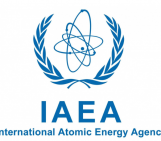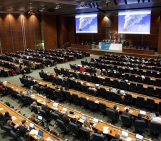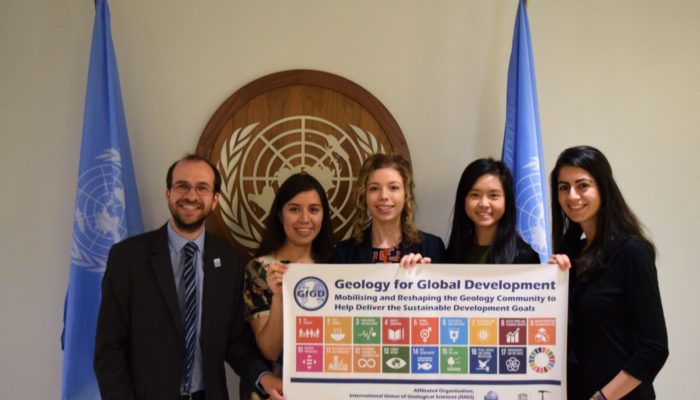
Geotalk is a regular feature highlighting early career researchers and their work. In this interview we speak with Joel Gill who a geoscientist, based in the UK, who works at the British Geological Survey, supporting their international development programmes, whilst also researching multi-hazards and disaster risk reduction. In addition he leads a not-for-profit organisation, Geology for Global Development, which operates internationally, championing the ways that geoscientists can help deliver the UN Sustainable Development Goals and one of our network blogs. He also helps lead the EGU’s multi-hazards sub-division, and is a Trustee of the Geological Society of London.
Hi Joel, thank you for talking with me today! To start with, can you tell me a bit about the Sustainable Development Goals?
The Sustainable Development Goals (or SDGs) convey a shared vision of a better, more equitable and sustainable world. Agreed in 2015 by United Nations member states, there are 17 SDGs and 169 targets, that collectively aim to finally end global poverty and unsustainable consumption patterns, and facilitate sustained and inclusive economic growth, social development, and environmental protection by 2030
A lot of the goals seem to be about very specific topics, so how do the SDGs relate to geoscience?
Each of the 17 SDGs is focused on quite a broad theme (e.g., health and wellbeing, gender equality, sustainable cities, life on land, strong institutions), with more specific targets sitting within the broader themes. Many of these targets highlight issues linked to the natural environment, resource management, resilience, and research and innovation. The SDGs are ‘science intensive’ and when you explore the targets in more detail, it is clear there is a lot the geoscience community can contribute.
For example, SDG 3 (Good Health and Wellbeing) has a target to ‘substantially reduce the number of deaths and illnesses from hazardous chemicals and air, water and soil pollution and contamination’. Research and other professional practice in hydrogeology, soil science, geochemistry, and atmospheric sciences (the work of many of those involved in EGU) will be fundamental to improving understanding of processes resulting in pollution and contamination, potential pollution pathways, and mitigation steps.
As well as the targets where geoscience research can help, there are also targets where geoscientists must take responsibility in their own spheres of influence for promoting cultural change. For example, ensuring we meet the full ambitions of the Gender Equality goal (SDG 5) will require action from all sectors and disciplines. The engineering, political science or visual arts communities won’t take responsibility for championing SDG 5 in geoscience! We need to champion and support excellent initiatives, such as Girls into Geoscience, which are supporting greater equality and inclusion.
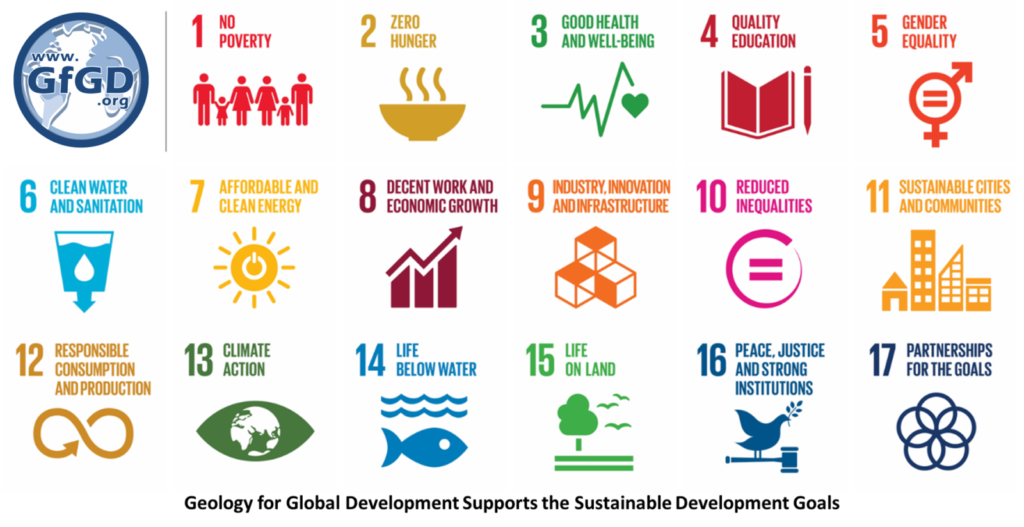
The 17 Sustainable Development Goals cover a wide range of themes from Gender Equality to Clean and Affordable Energy (Image credit: Geology for Global Development, created in accordance with the UN guidelines)
The UN has just announced that 2020 is the beginning of the ‘Decade of Action’, what does this mean?
Business as usual is not enough to meet the ambitions of the SDGs. We need more people and groups to be prepared to help deliver sustainable solutions to some of the world’s most pressing global challenges – from eradicating extreme poverty (SDG 1) to ensuring our oceans thrive (SDG 14). At our current rate of progress, it will be hundreds of years before we ensure universal access to water and sanitation (SDG 6) or achieve gender equality (SDG 5) in some regions. The decade of action recognises that to meet the SDGs by 2030 we need to engage at a greater scale and speed, but also that this engagement needs to be appropriate and result in meaningful, long-lasting change.
One of the things the UN statement mentions, is that change will need to happen at three levels: global action; local action; and people action. What kinds of things can geoscientists do, to get involved at these different levels?
Let me take each in turn:
Global Action: This is about pushing for strong international leadership, more resources and smarter solutions for the SDGs. The geoscience community is woefully underrepresented at large sustainability forums. We just don’t turn up, and therefore access to our expertise and insights is lost. We need to break out of our comfort zones (such as traditional scientific conferences) and be active and present in new spaces. For the last two years, Geology for Global Development has represented the geoscience community at the UN Forum on Science, Technology, and Innovation (STI) for the SDGs. Without our leadership and engagement, key issues around the environmental implications of new technologies or the importance of the sub-surface in sustainable cities would not have been raised.
What can you do?
- Firstly, you can turn up and increase understanding and access to geoscience knowledge – there are regional STI forums (e.g., the African Forum is 24-25 February) as well as the global forum to engage in. Where possible, collaborate and support existing initiatives, because engaging in UN processes can be confusing and complex. Working with groups like Geology for Global Development who have experience and contacts can help you to navigate this space.
- In addition, you can contribute to online consultations and calls-for-evidence. For example, there was an open call for evidence to inform the Global Sustainable Development Report 2019, a flagship UN report.
Local Action: The SDGs, although set at a global level, need to be implemented and reported on at national and regional levels. Local action is therefore about ‘embedding the needed transitions in the policies, budgets, institutions and regulatory frameworks of governments, cities and local authorities’. Research into the geothermal potential of a particular region, for example, could then inform planning tools and incentives that encourage greater use of geothermal energy to heat homes – contributing to SDG 7 (clean and affordable energy), SDG 11 (sustainable cities) and SDG 13 (climate action).
What can you do?
- Build your own skills in connecting science with policy by taking advantage of opportunities such as the EGU Policy Pairing scheme (and their broader policy work) or national equivalents coordinated by other organisations and research funders.
- Engage with a broad range of stakeholders at the start of research design, and include policy-makers and those with policy analysis and ‘knowledge broker’ expertise in your research teams.
- Provide examples of geoscience research and practice that is helping to deliver the SDGs to Voluntary National Reviews – the reports prepared by national governments and presented at the United Nations. Each country prepares these in a different way, but the UK Government made a call for case studies to inform their review, and the final version profiled the work of the British Geological Survey.
People Action: The final aspect of the decade of action is all about stakeholders (including scientists) catalysing a movement that advocates for the changes needed to achieve the SDGs. For geoscientists, this is about using our networks, experiences and skills to influence those around us in order to raise the profile of the SDGs and promote the social and professional changes needed to deliver them.
What can you do?
- Talk to your colleagues about the SDGs and what they mean at an individual and organisational level, and then think about how your organisation can support broader social movements and help to deliver the SDGs. For example, the Geological Society of London recently gathered a diverse set of people to explore responsible investing in natural resources and what this means in the context of the SDGs.
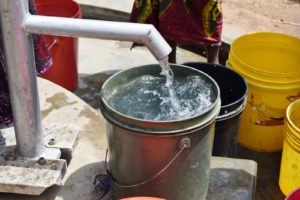
There are many ways, both research related and cultural, that geoscientists can engage with the SDGs (Photo credit: Joel Gill)
So if our members wanted to learn more about the SDGs and how they can get involved, where can they go?
For general resources and commentary, the Geology for Global Development website has a set of articles and reports that discuss how geoscientists can contribute to the SDGs. This includes an initial review of links between geoscience and the SDGs. A briefing note on Geology and the SDGs has also been published by the Geological Society of London, as well as this fantastic poster. You can also support our work, which is currently done mostly by volunteers, here.
There is a new book ‘Geosciences and the SDGs’ which will be released in August 2020, that I edited. This book has authors from all over the world, and includes a chapter on each of the SDGs and examples of the contributions that geoscientists can make to delivering them. There are teaching resources to help include the SDGs in geoscience teaching, and infographics to summarise each chapter.
I’ll be supporting a short course at the EGU General Assembly 2020, with discussion of the SDGs themselves, and ways to engage as a geoscientist. It would be great to see many of you there, and to hear your ideas about how we can ensure geoscience is embedded into sustainability decision making.
For those looking for small amounts of funding to help connect geoscience to the SDGs, have a look at the IUGS/UNESCO International Geoscience Programme. Science partnerships are at the heart of the International Geoscience Programme, which provides funding to facilitate global cooperation, build capacity, and disseminate science that serves society. For more information read this article.
Finally, take some time to explore the UN sustainable development web pages, and think about what it means for your specific area of work. Look at the SDGs and their targets and consider where your research or work could help to achieve some of these, and think about the stakeholders needed to move from research output to development outcome and impact. The pathways and people will differ from theme to theme, and from country to country.
Interview by Hazel Gibson, EGU Communications Officer.


